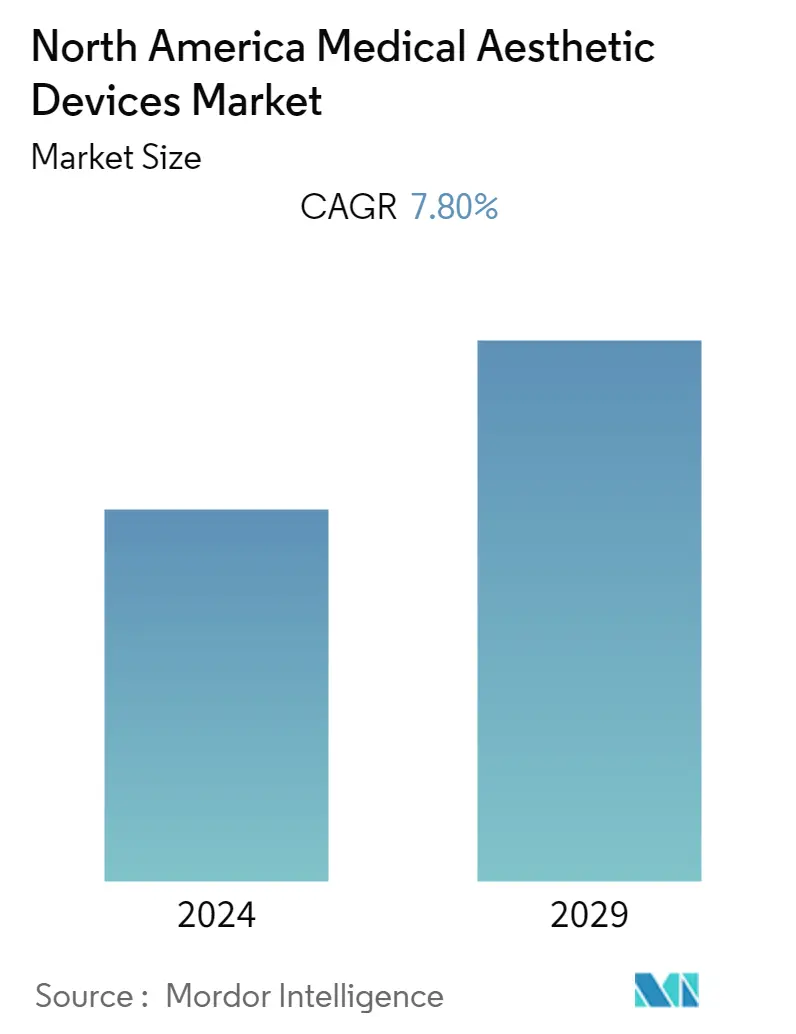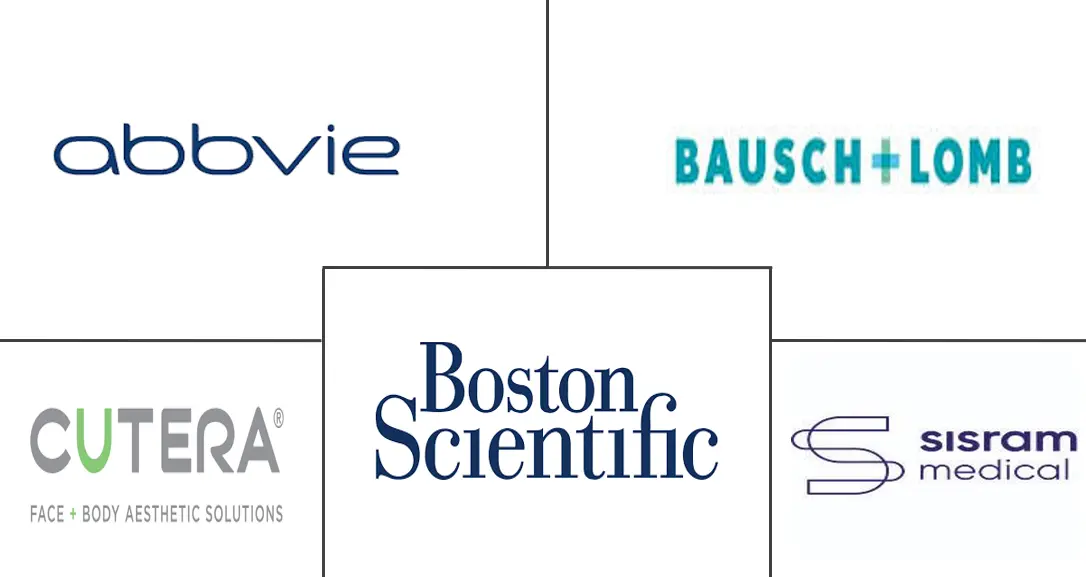Market Size of North America Medical Aesthetic Devices Industry

| Study Period | 2019 - 2029 |
| Base Year For Estimation | 2023 |
| Forecast Data Period | 2024 - 2029 |
| Historical Data Period | 2019 - 2022 |
| CAGR | 7.80 % |
Major Players
*Disclaimer: Major Players sorted in no particular order |
North America Medical Aesthetic Devices Market Analysis
The North America Medical Aesthetic Devices Market is expected to register a CAGR of 7.8% over the forecast period
COVID-19 pandemic has had a substantial impact on the North America medical aesthetic devices market initially. For instance, an article published in the Journal of Clinics in Dermatology in June 2021 indicated that various procedures, such as deep peeling and laser treatments, were avoided during the COVID-19 pandemic because of the disruptions in the skin barrier. Also, the procedures, such as high-intensity focused ultrasound, fractional radiofrequency, and cryolipolysis equipped with stainless steel, gold, or plastic handpieces and probes, were postponed due to the risk of contamination. However, aesthetic devices that consumers could use in their homes increased after the COVID-19 pandemic. According to an article published in the International Journal of Trichology in February 2022, home-based aesthetic devices have increased in recent years. They became more relevant during the COVID-19 pandemic, as more patients were hesitant to visit clinics for non-emergency reasons. Thus, the COVID-19 outbreak affected the market's growth adversely in its preliminary phase; however, the market is expected to gain traction due to the significant increase in the use of medical aesthetic devices globally.
Further, the rapidly increasing aging population, increasing obese population and increasing awareness regarding aesthetic procedures and rising adoption of minimally invasive devices are among the major factors driving the growth of the studied market. For instance, in July 2021, Allergan received the US FDA approval of a label expansion of BOTOX to include eight new muscles for the treatment of upper limb spasticity in adults. The new muscles for treatment include additional muscles of the elbow and forearm (brachialis, brachioradialis, pronator teres, and pronator quadratus). Thereby, the approval for minimal invasive procedures is elevating the need for minimally invasive devices, hence this is going to promote the market growth.
Additionally, according to the U.S. Census Bureau, in 2022, it has been stated that more than 56 million adults ages 65 and older live in the United States, accounting for about 16.9% of the nation's population, and by 2030 it is projected that there will be more than 73.1 million older adults. Thereby, such factors are going to elevate the need for cosmetic surgeries and various other procedures which will help a individual look younger, thereby this is going to elevate the growth of the market.
Therefore, owing to the aforementioned factors the studied market is anticipated to witness growth over the analysis period. However, the side effects of the aesthetic devices and poor reimbursement scenario help to restrain the overall market growth.
North America Medical Aesthetic Devices Industry Segmentation
As per the scope of the report, aesthetic devices refer to all medical devices that are used for various cosmetic procedures, which include plastic surgery, unwanted hair removal, excess fat removal, anti-aging, aesthetic implants, skin tightening, and others, that are used for beautification, correction, and improvement of the body. The North America medical aesthetic devices market is segmented by Type of Device (Energy-based Aesthetic Device (Laser-based Aesthetic Device, Radiofrequency (RF) Based Aesthetic Device, Light-based Aesthetic Device, and Ultrasound Aesthetic Device) and Non-energy-based Aesthetic Device (Botulinum Toxin, Dermal Fillers and Aesthetic Threads, Microdermabrasion, Implants, and Other Aesthetic devices)), Application (Skin Resurfacing and Tightening, Body Contouring and Cellulite Reduction, Hair Removal, Facial Aesthetic Procedures, Breast Augmentation, and Other Applications), End-User (Hospitals, Clinics, and Home Settings), and Geography (United States, Canada, and Mexico).
| By Type of Device | |||||||
| |||||||
|
| By Application | |
| Skin Resurfacing and Tightening | |
| Body Contouring and Cellulite Reduction | |
| Hair Removal | |
| Facial Aesthetic Procedures | |
| Breast Augmentation | |
| Other Applications |
| By End User | |
| Hospitals | |
| Clinics | |
| Home Settings |
| Geography | |
| United States | |
| Canada | |
| Mexico |
North America Medical Aesthetic Devices Market Size Summary
The North America medical aesthetic devices market is poised for significant growth, driven by a combination of factors including an aging population, increasing obesity rates, and heightened awareness of aesthetic procedures. The market experienced initial setbacks due to the COVID-19 pandemic, which led to a temporary decline in clinic visits for procedures like deep peeling and laser treatments. However, the pandemic also spurred a rise in the use of home-based aesthetic devices as consumers sought alternatives to in-clinic treatments. The approval of minimally invasive procedures, such as the expansion of BOTOX treatments, has further fueled market demand. Despite challenges like side effects and reimbursement issues, the market is expected to expand as more individuals seek cosmetic solutions to enhance their appearance.
The United States is anticipated to be a key driver of market growth, supported by a surge in aesthetic procedures and technological advancements. The popularity of botulinum toxin injections, particularly among younger demographics, underscores the growing acceptance of minimally invasive treatments. The market's competitive landscape is characterized by the presence of both global and regional players, including Abbvie Inc. and Bausch & Lomb Incorporated, who continue to innovate and expand their product offerings. Regulatory approvals, such as those for the PicoSure Pro device and RHA Redensity dermal filler, further indicate a robust market trajectory. As the demand for cosmetic procedures continues to rise, the North American medical aesthetic devices market is expected to witness sustained growth over the forecast period.
North America Medical Aesthetic Devices Market Size - Table of Contents
-
1. MARKET DYNAMICS
-
1.1 Market Overview
-
1.2 Market Drivers
-
1.2.1 Rapidly Increasing Aging Population
-
1.2.2 Increasing Obese Population
-
1.2.3 Increasing Awareness Regarding Aesthetic Procedures and Rising Adoption of Minimally Invasive Devices
-
-
1.3 Market Restraints
-
1.3.1 Side Effects of the Aesthetic Devices
-
1.3.2 Poor Reimbursement Scenario
-
-
1.4 Porter's Five Force Analysis
-
1.4.1 Threat of New Entrants
-
1.4.2 Bargaining Power of Buyers/Consumers
-
1.4.3 Bargaining Power of Suppliers
-
1.4.4 Threat of Substitute Products
-
1.4.5 Intensity of Competitive Rivalry
-
-
-
2. MARKET SEGMENTATION
-
2.1 By Type of Device
-
2.1.1 Energy-based Aesthetic Device
-
2.1.1.1 Laser-based Aesthetic Device
-
2.1.1.2 Radiofrequency (RF)-based Aesthetic Device
-
2.1.1.3 Light-based Aesthetic Device
-
2.1.1.4 Ultrasound Aesthetic Device
-
-
2.1.2 Non-energy-based Aesthetic Device
-
2.1.2.1 Botulinum Toxin
-
2.1.2.2 Dermal Fillers and Aesthetic Threads
-
2.1.2.3 Microdermabrasion
-
2.1.2.4 Implants
-
2.1.2.5 Other Aesthetic Devices
-
-
-
2.2 By Application
-
2.2.1 Skin Resurfacing and Tightening
-
2.2.2 Body Contouring and Cellulite Reduction
-
2.2.3 Hair Removal
-
2.2.4 Facial Aesthetic Procedures
-
2.2.5 Breast Augmentation
-
2.2.6 Other Applications
-
-
2.3 By End User
-
2.3.1 Hospitals
-
2.3.2 Clinics
-
2.3.3 Home Settings
-
-
2.4 Geography
-
2.4.1 United States
-
2.4.2 Canada
-
2.4.3 Mexico
-
-
North America Medical Aesthetic Devices Market Size FAQs
What is the current North America Medical Aesthetic Devices Market size?
The North America Medical Aesthetic Devices Market is projected to register a CAGR of 7.80% during the forecast period (2024-2029)
Who are the key players in North America Medical Aesthetic Devices Market?
Abbvie Inc. (Allergan PLC), Bausch & Lomb Incorporated, Sisram Medical (Alma Lasers), Cutera Inc. and Boston Scientific (Lumenis Inc.) are the major companies operating in the North America Medical Aesthetic Devices Market.

